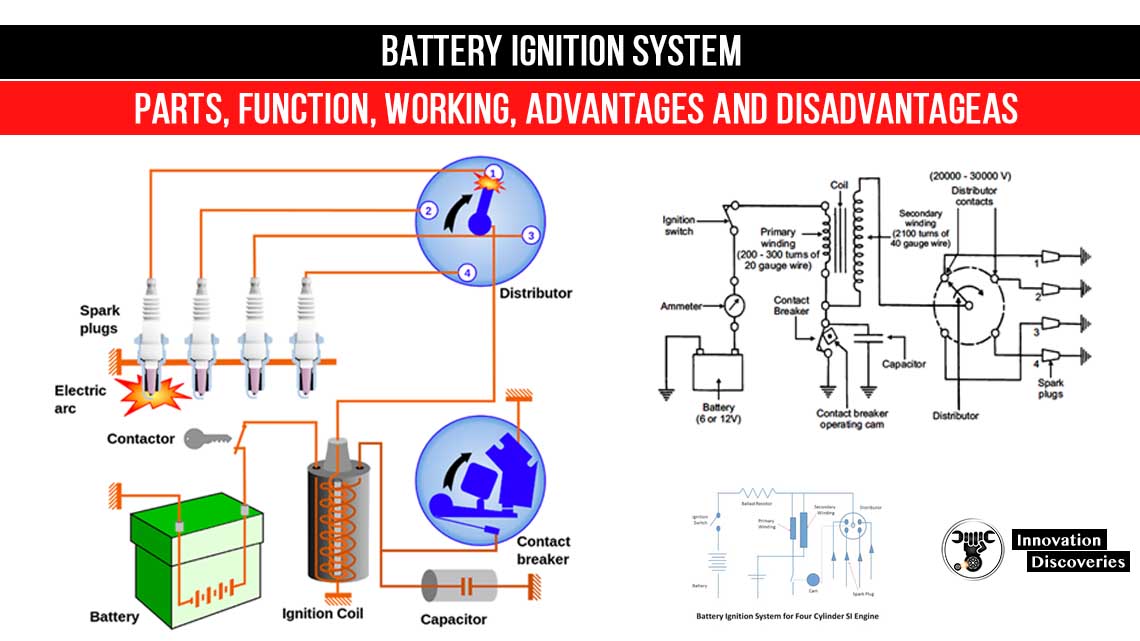
Most SI engines used the battery ignition system. In this system, a 6 volt or 12-volt battery is used to produce a spark.
Passenger cars, light trucks, motorcycles, and large stationary engines are fitted with this system
Read More: Difference Between SI engine and CI engine
Battery ignition system:
Battery Ignition System: Parts, Function, Working, Advantages, and Disadvantage
Main Parts of the battery ignition system
Battery
A battery is used to provide energy for ignition.
It is work as storage of energy and charged by dynamo, which is driven by an engine.
It converts chemical energy into electric energy.
Two types of battery used in the spark ignition system, lead-acid battery, an alkaline battery.
The first one is used in light-duty commercial vehicles and the other one is used in heavy-duty commercial vehicles.
It is housed on the primary side of the ignition coil.
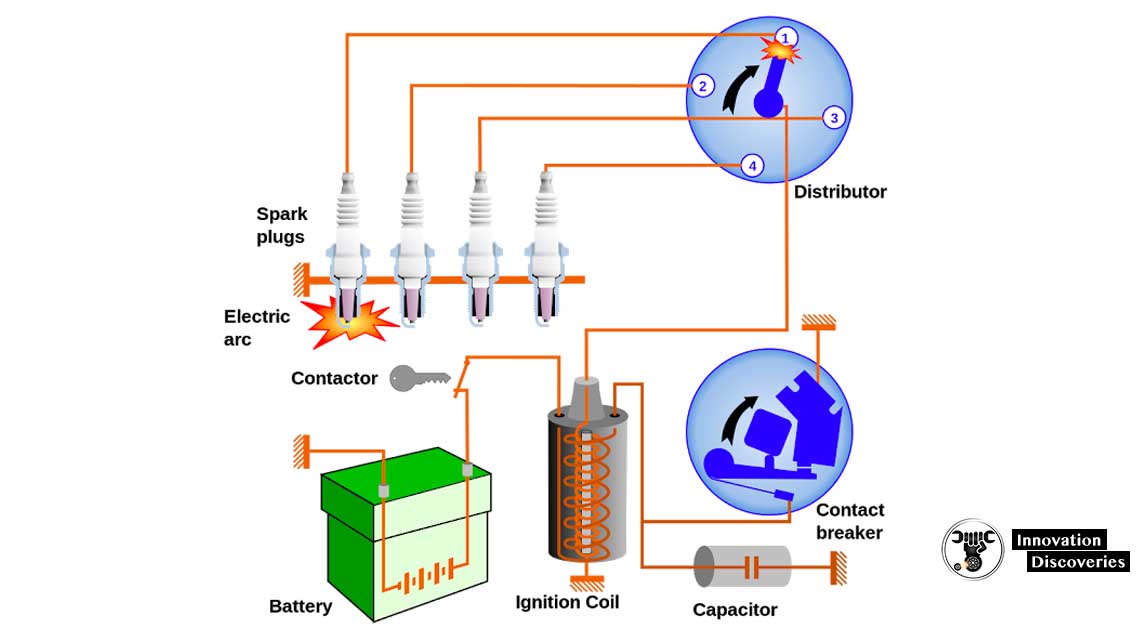
Ignition switch
It is used to turn on and off the ignition system.
The battery is connected to the primary winding of the ignition coil by an ignition switch and ballast resistor
Ballast resistor
To regulate the current in the primary winding, it is connected in series with the primary winding.
It is used to prevent injury due to the overheating of the ignition coil. It controls the current passes through the primary winding.
That is made of iron. Iron has the property of increase electrical resistance rapidly by an increase in temperature at a certain limit.
This additional resistance resists flowing current which controls the temperature of the ignition coil
Ignition coil
The ignition coil is the main body of the battery ignition system.
The purpose of the ignition coil to step up the battery voltage (6 or 12) to a high voltage, which is sufficient to produce a spark at a spark plug.
It consists of a magnetic core or soft wire or sheet, and two electrical winding called primary winding and secondary winding.
The primary winding has generally 200-300 turn and the end is connected to an exterior terminal.
The secondary has almost 21000 turns of copper wire which are insulated to withstand high voltage.
It is located inside the primary winding and its one end connected to the secondary winding and the other end is grounded either to the primary winding or to the metal case.
This entire unit is enclosed in a metal container which makes it a compact unit
Contact breaker
This is a mechanical device making and breaking the primary circuit to the ignition coil. When the points are closed current flow in the ignition coil and when it open, the flow of current stopped
Capacitor
It is a simple electrical capacitor in which two metal plates are separated by an insulating material with a distance.
Commonly air is used as insulating material but for particular technical requirements, some high-quality insulating material is used.
Read More: CAPACITOR-DISCHARGE IGNITION(CDI) WORKING PRINCIPLE, ITS ADVANTAGE AND DISADVANTAGE
Distributor
The distributor is used in a multi-cylinder engine to regulate spark in each spark plug in the correct sequence. It distributes the ignition surge in an individual spark plug in the correct sequence.
Read More: HOW IGNITION DISTRIBUTOR WORKS?
There are two types of distributors.
One is known as carbon brush type and the other one is gap type.
In carbon brush type carbon brush carried by the rotor arm sliding over the metallic segment embedded into the distributor cap or molded insulating material.
This makes an electric connection or secondary winding with the spark plug.
In gap type distributor electrode of rotor arm pass close to but does not make contact with the distributor cap. So there is no wear of electrode.
Spark Plug
A spark plug generally has two electrodes that are separated from each other.
A high potential discharge flow through it generate spark and ignite the combustion mixture in the cylinder.
Read more: NGK VS DENSO – WHICH SPARK PLUG IS THE BETTER CHOICE?
It mainly consists of two electrodes a steel shell and an insulator.
The central electrode is connected with the supply of the ignition coil.
It is well insulated with the outer steel shell which is grounded.
There is a small air gap between the steel shell and the central electrode, between which spark is generated.
The electrode is usually made by high nickel alloy so it can withstand high temperature and corrosion resistance.
Working of Battery Ignition System:
In the battery ignition system ignition coil stores the energy in form of the magnetic field and deliver it at the instant of ignition, in form of a high voltage current with high tension wire to correct the spark plug.
The diagram of a four-cylinder battery ignition system is as follows.
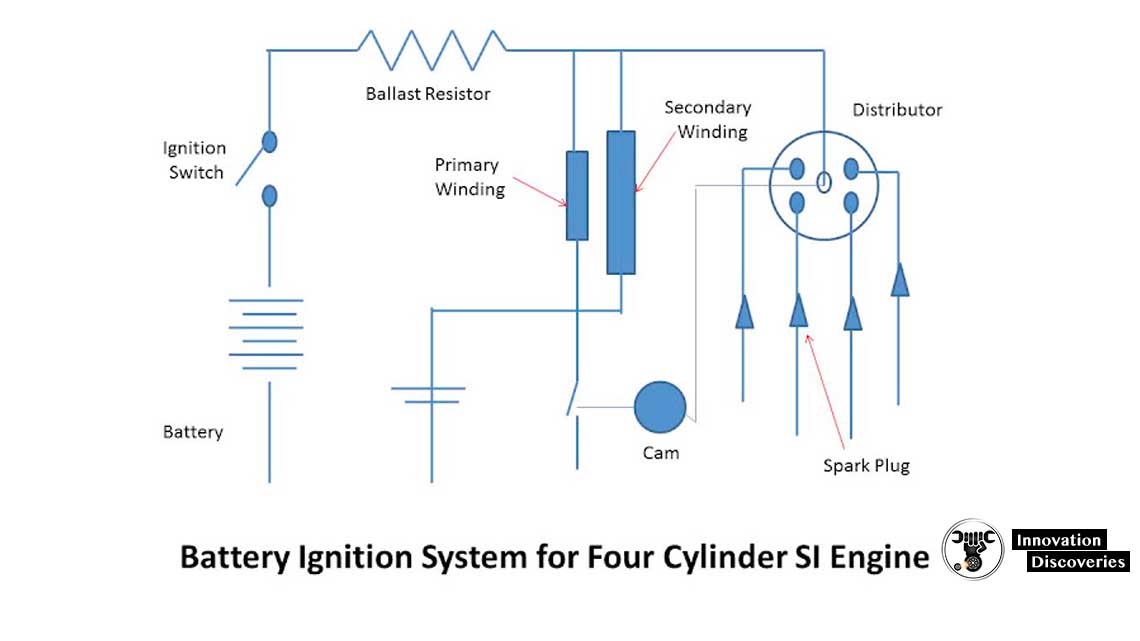
Battery Ignition System: Parts, Function, Working, Advantages, and Disadvantages
First low voltage current flow from the battery to the primary coil through the ignition switch and ballast resistor.
The ballast resistor regulates the temperature of the ignition coil by regulating current passing from it.
The ignition capacitor is connected in parallel with a contact breaker.
One end of the secondary winding is also grounded through the contact breaker.
When the ignition switch is closed, the primary winding of the coil is connected to the positive terminal and the current flow through it known as the primary current.
The current flows from the primary coil produce a magnetic field which induces an EMF in the secondary coil.
The cam regulates the contact breaker. Wherever the breaker open, current flows into the condenser, which charged the condenser.
As the condenser becomes charger the primary current falls and the magnetic field collapses.
This will induce a much higher voltage in a condenser.
Now the condenser discharge into the battery which reverses the direction of both primary current and magnetic field.
This will induce a very high EMF in the secondary winding.
Now, this high voltage EMF produces a spark at the correct spark plug through a distributor.
Advantages and Disadvantages:
Advantages:
- 1. At the time of starting or at low speed good spark is available.
- 2. The battery which is used to generate spark can be used to light other auxiliaries like headlight, tell light, etc.
- 3. Initial expenditure is less and it has a low maintenance cost.
- 4. Ignition system is not affected by adjusting spark timing in the battery ignition system.
Disadvantages:
- 1. Time available built up the current and stored energy is decreasing as the speed of the engine increases.
- 2. Contact breaker subjected to both electrical and mechanical wear which results in short maintenance interval.
- 3. The primary voltage decreases as the engine speed increase. So it is not fully reliable for high-speed engines.
- It is all about battery ignition system parts, principle, working, advantages, and disadvantages.
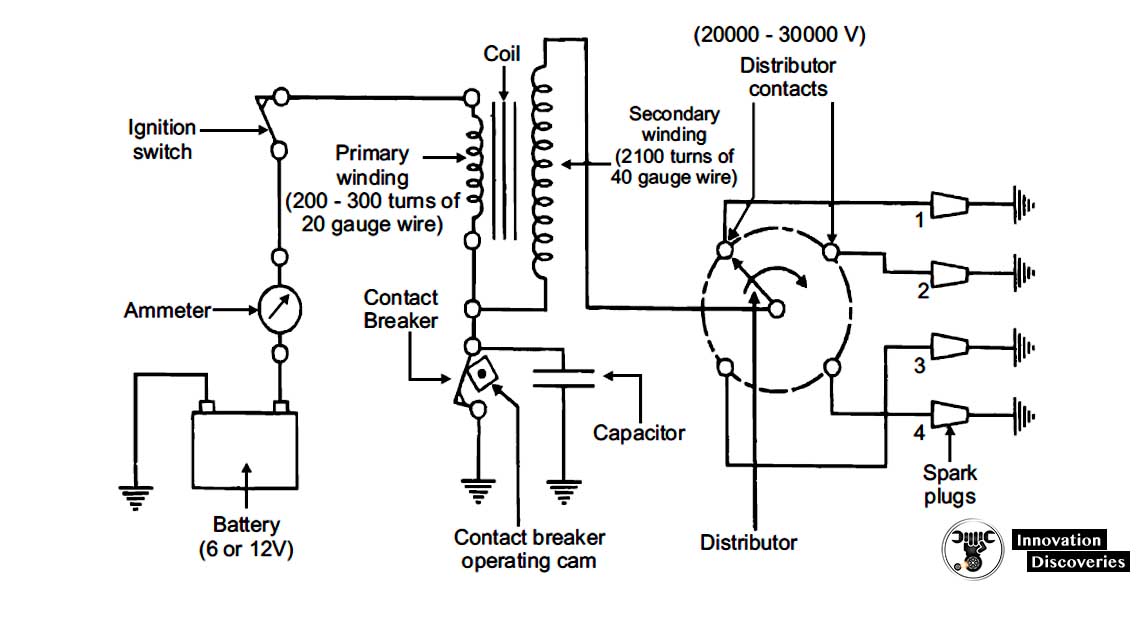
Read More:
Visit Forum
Visit Our Friendly Website



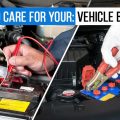

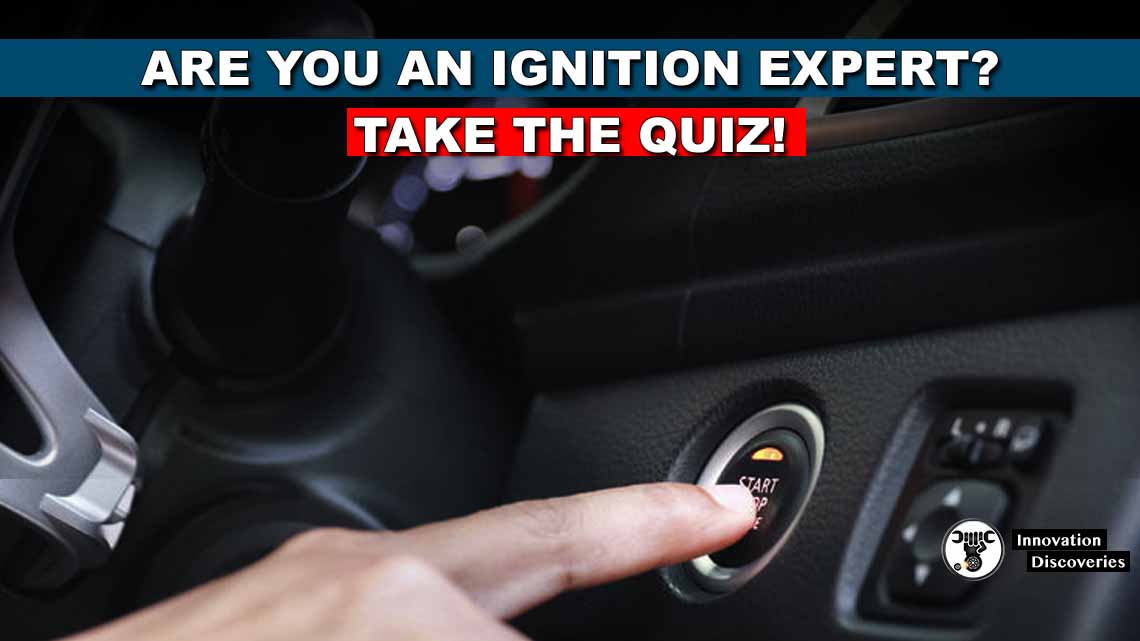
14 Comments